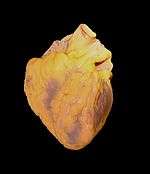Traumatic cardiac arrest
Traumatic cardiac arrest (TCA) is a condition in which the heart has ceased to beat due to blunt or penetrating trauma, such as a stab wound to the thoracic area.[1] It is a medical emergency which will always result in death without prompt advanced medical care. Even with prompt medical intervention, survival without neurological complications is rare.[2] There are no definitive protocols in place in how to manage traumatic cardiac arrest, but certain people benefit from the use of a thoracotomy in order to gain access and repair damage from the injury.[3] Traumatic cardiac arrest is a complex form of cardiac arrest often derailing from Advanced Cardiac Life Support in the sense that the emergency team must first establish the cause of the traumatic arrest and reverse these effects, for example hypovolemia and haemorrhagic shock due to a penetrating injury.
| Traumatic cardiac arrest | |
|---|---|
 | |
| Human heart | |
| Specialty | Cardiology |
References
- Hunt PA, Greaves I, Owens WA (January 2006). "Emergency thoracotomy in thoracic trauma-a review". Injury. 37 (1): 1–19. doi:10.1016/j.injury.2005.02.014. PMID 16410079.
- Gräsner JT, Wnent J, Seewald S, et al. (2011). "Cardiopulmonary resuscitation traumatic cardiac arrest--there are survivors. An analysis of two national emergency registries". Critical Care (London, England). 15 (6): R276. doi:10.1186/cc10558. PMC 3388703. PMID 22108048.
- Cothren CC, Moore EE (2006). "Emergency department thoracotomy for the critically injured patient: Objectives, indications, and outcomes". World Journal of Emergency Surgery. 1: 4. doi:10.1186/1749-7922-1-4. PMC 1459269. PMID 16759407.